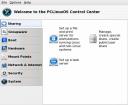This is an important update to this review:
A standard feature of mainstream multimedia PCs and laptops has been the ability of being able to record digital sound… if you think that this feature is important to you or someone you know you may want to read this before purchasing a Lenovo Thinkpad.
A few weeks ago I wrote about my experiences installing several different distributions on my ThinkPad T61. One of the distributions I tested was PCLinuxOS 2007. And, as I wrote, there were a couple of small issues that I had to fiddle with in order to get everything working. With the recent release of the 2008 version of PCLinuxOS (the Mini Me version which comes with a minimal number of applications pre-installed), I thought it would be good to write about how this new version works on my laptop. However, that could be summarized in just one phrase: It just works! That is right, everything worked out-of-the-box, wireless networking, 3D acceleration and Compiz-Fusion, sound, etc. For those of you that didn’t read my previous writeup, let me post the specs of my machine again:
- ThinkPad T61
- Intel Core 2 Duo (2.0 GHz 2MBL2)
- 15.4 WSXGA+ TFT display
- Intel GMA X3100 GM965 (video card)
- 2 GB RAM
- 160 GB 7200 rpm hard drive
- Intel/PRO Wireless 3945ABG
So, instead of boring you with yet another review of the very easy to use installer, lets move on to what it is like to use PCLinuxOS. But, before I do that, let me tell you a little bit about what PCLinuxOS is about and why you should be interested in it.
Why PCLinuxOS
PCLinuxOS is a Linux distribution that aims to provide the best of what free software has to offer in an easy to install, easy to use, and easy to maintain package, especially for the home user. Its developers also seem to care about making it visually attractive because every iteration I have been privileged to use has been strikingly beautiful. This latest incarnation, the 2008 version, is certainly a good example of this.
PCLinuxOS has a motto that is very fitting: “Radically Simple”. In this case, the word “simple” refers to how trivial it is to do things in PCLinuxOS when compared to many other Linux distributions. The PCLinuxOS developers try hard to make things this way. And, as you will see latter in this review, they have managed to do this to an admirable degree.
PCLinuxOS Highlights
The “Utilities” folder on the desktop of the 2008 version is a good example of how the PCLinuxOS developers try to make things easy to use. These are its contents:

As you can see this folder has several shortcuts. Each of these leads to a “wizard” that aids you in doing the corresponding task. Some of these may not be needed by you (for example, I did not need the ATI-Nvidia Driver Install). 😉 But others may prove to be handy. Placing them right on the desktop makes for easy discovery.
PCLinuxOS developers make no secret of the fact that they have benefited from the work done by other distributions, especially Mandriva. Free software makes this legal and completely ethical. In fact, all Linux distributions benefit from the code done by others, and many popular Linux distributions are derived directly from other distributions. One important feature of PCLinuxOS that came from Mandriva is the PCLinuxOS Control Center. The PCLinuxOS Control Center (PCC) is certainly one of the most important features of the distro.
We will take a closer look at the PCC later in this review, but suffice it to say for now that it is a very convenient and polished tool to configure some important operations of the computer.
PCLinuxOS uses a program called Synaptic for package management (add/remove programs).
This application has the reputation of being the best package manager available on Linux. People debate the merits of that reputation to no end. Some say that there are other package managers that are just as good, but that it is the quality of the packages being managed that makes the difference. In either case, the PCLinuxOS maintainers have done an excellent job so far in providing a very satisfying experience in this regard – the best I have experienced in Linux. With PCLinuxOS you don’t have to completely reinstall your OS every time a new version comes out. Updates are continuously being added to the package repository. So, as long as you keep up with installing them, your machine will always have the latest and greatest*.
*Note: Every so often the developers have to break the “rolling release” upgrade method due to unavoidable reasons. But that is not a frequent occurrence.
Providing all the software needed to run a computer and its peripherals is no easy task. There are still a lot of devices that will not run on Linux. However, Linux in general is making huge advancements in the hardware compatibility front, and PCLinuxOS in particular does a very good job of taking advantage of this. There are thousands of satisfied PCLinuxOS users that are enthusiastic about finally finding a Linux distribution that “just works” for them. You can read their experiences in the PCLinuxOS forum. No wonder PCLinuxOS has been affectionately called “the distro hopper stopper”.
So, what can we do on PCLinuxOS? We’ll get into that on Part 2 of this review.




Leave a comment